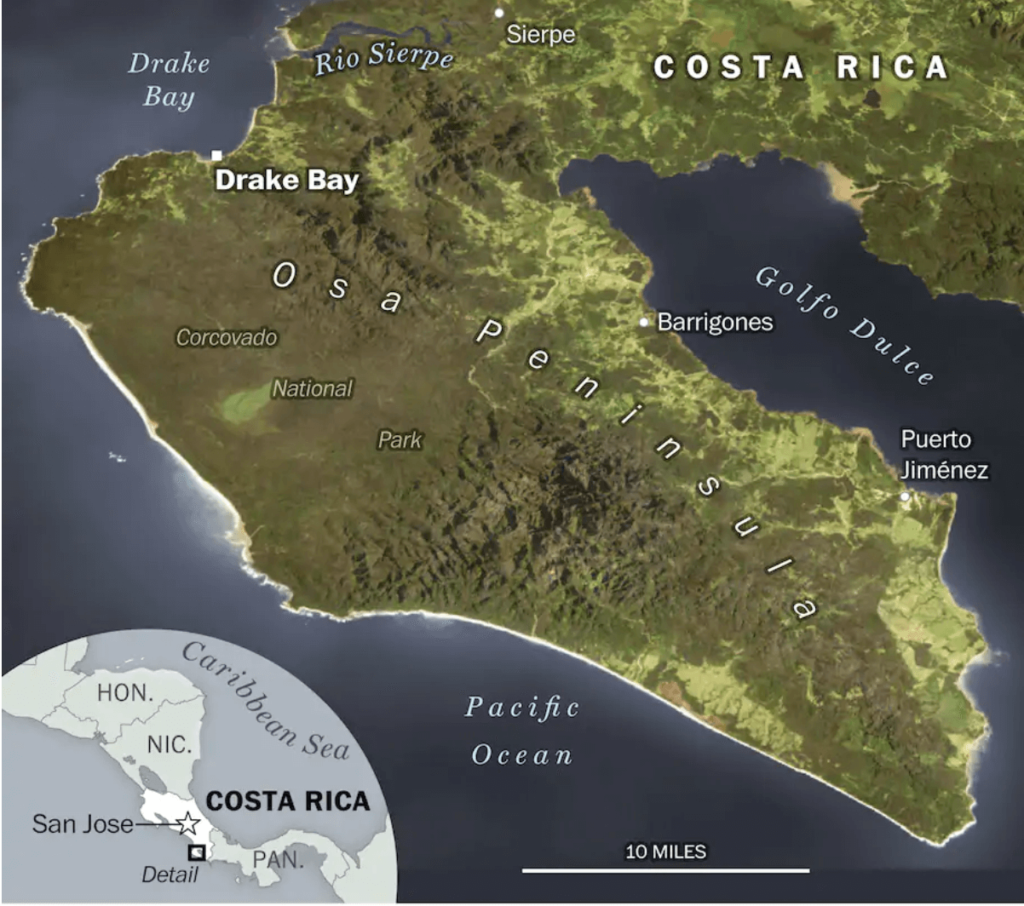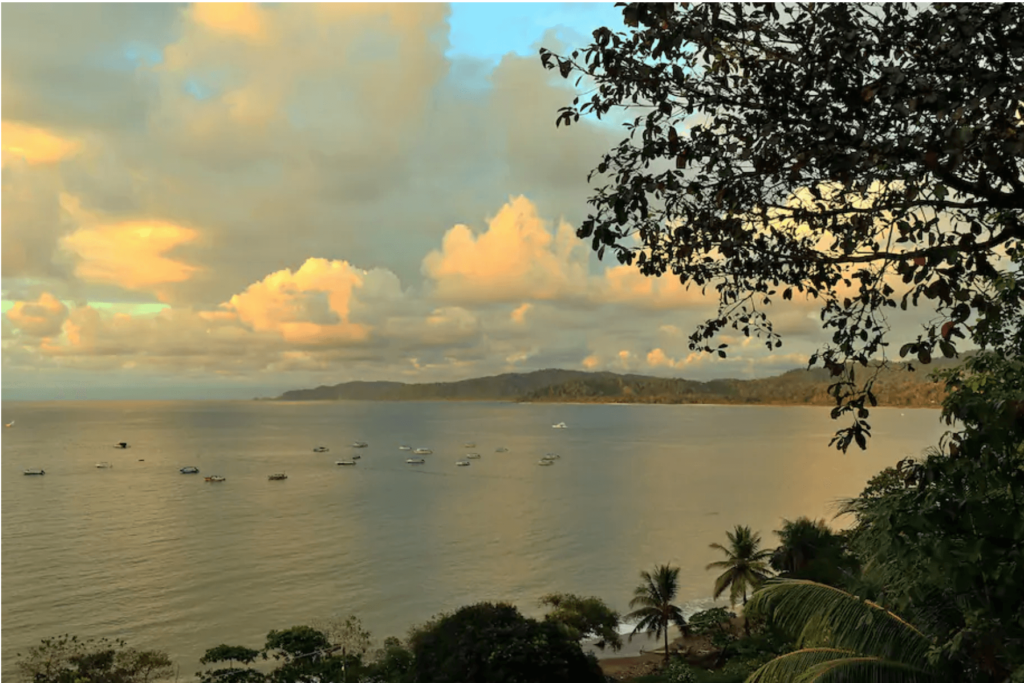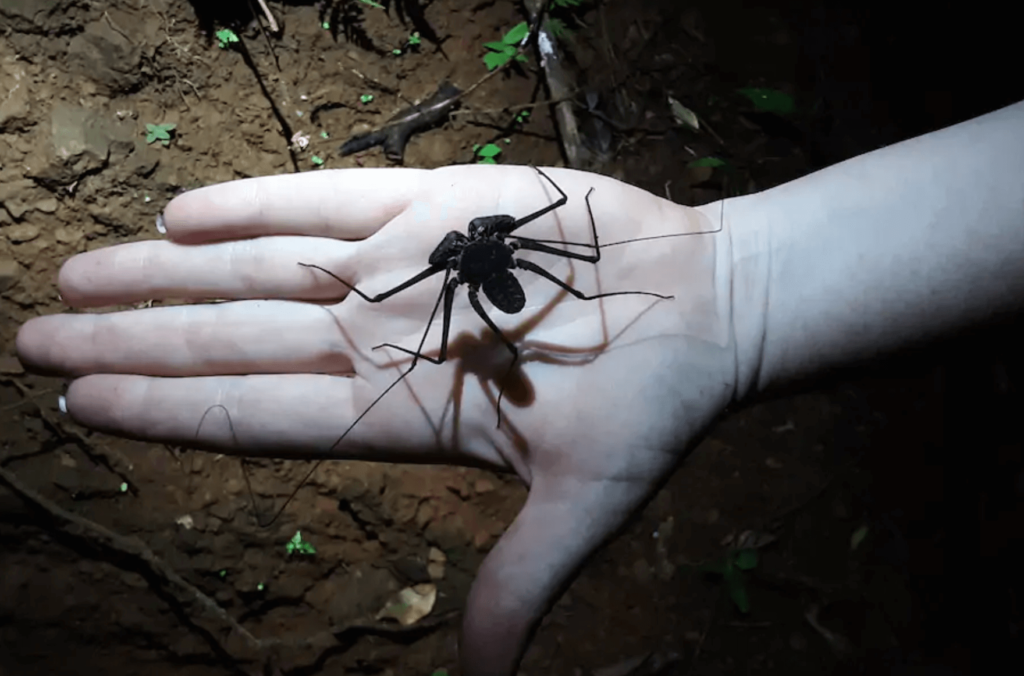Costa Rica’s ‘biologically intense’ Osa Peninsula is truly wild
Wednesday 6 March, 2019 - Author: M.L. Lyke

A wild chestnut-mandibled toucan sits on a branch in Drake Bay, on the Osa Peninsula in Costa Rica. (Alamy Stock Photo)
Squawking parrots fly tree to tree, waking up the little village of Drake Bay on Costa Rica’s Osa Peninsula. They’re right on time, shortly after 5 a.m., a fine hour to get up and enjoy the cool of morning before heat and humidity set in. I throw on shorts and tennies and hit the nearby jungle path that heads south along the coast, stepping carefully, trying not to make noise: heel first, roll the sole, shhhh.
They know I’m there. I can feel their eyes on me as I move, see bits of them through trees: a foot-long, spiky iguana regarding me with a prehistoric stare; a white-faced capuchin monkey throwing an inquisitive glance from a tree; a macaw, in primary reds and blues and yellows, rolling a hooded eye from on high. Venomous vipers hide in undergrowth, spiders in tree bark. A morpho butterfly flashes Avatar blue.
I am surrounded by animals — not tourists, whose voices are happily missing from the symphony of sawing katydids, chirping frogs and singing birds. Here, I’m species .000001. The sensation is lush, primordial, an eco-immersion in one of the great untamed wildlife kingdoms of the world.
Where rain forest meets seashore: In Costa Rica, do it all without breaking the bank
National Geographic has described the remote Osa Peninsula as one of the most “biologically intense” places on Earth. It hosts more than 50 percent of the country’s animal and plant species, while covering only 3 percent of Costa Rica’s land area.
Here, animals rule, nature-lovers drool. And locals struggle to find a balance between making money off nature and protecting it. They’ve seen too many other dreamy green eco-destinations undone by development and rampant tourism. “There’s a fear that this place may get ruined, like so many beautiful places in Costa Rica,” says a longtime resident who has watched wealthy developers picking up properties up and down the coast in recent years.
The area’s best protection may be its isolation. Drake Bay can be challenging to get to.

Map of Costa Rica’s Osa Peninsula
Driving on the rough 4×4 dirt road that leads to Drake Bay is dicey in bad weather, and car-rental companies may not allow it. There are multiple river crossings that can flood and become impassable. A few buses make the trip, but the ride can be scary. “I wasn’t sure we were going to make it,” said one intrepid European traveler arriving by bus at the end of rainy season.
Flying in a prop plane from San Jose to Drake Bay’s small domestic airport is relatively easy. But most people come by boat from the docks of Sierpe, a small, sleepy town a little more than an hour’s boat ride north. It’s cheaper, and the breathtaking boat journey, with wet-exit finale, offers a proper introduction to this wild corner of the world.
We arrive an hour early at the docks, find our captain and check out the hulking 400-horsepower outboard on the stern of our canopied boat. A nearby boat has twin 250s. The trip to Drake Bay was nearly impossible before the advent of these high-powered brutes, a crew member tells us.
The captain cruises through the calm, mangrove-lined Rio Sierpe, stopping to check out baby crocs on the shore, then revs and heads into the tricky intersection where river meets sea. It is a mass of confusion today, water headed every which way, with black rocks jutting up through swells and surf. Our captain navigates expertly outside the river mouth and inside the break. Despite a few soakings when the boat goes airborne and slaps back down, we arrive safely at our destination, exiting the boat’s stern and wading ashore in knee-deep water to be greeted warmly by local “ticos,” as Costa Ricans call themselves

Most visitors come to Drake Bay by boat from the docks of Sierpe, a small, sleepy town a little more than an hour’s boat ride north. (Alamy Stock Photo)
We’ve come to Drake Bay from Manuel Antonio, whose national park and easy access from the capital of San Jose make it one of the most visited spots in Costa Rica. Tourists jam beaches and souvenir stands and queue up to get into the park, where some animals have become habituated to humans. Raccoons and monkeys are known to grab backpacks, unzip them and steal snacks and body wipes. (A guide told us that clever capuchins love to clean themselves with the wipes.) It’s cute, but sad. Definitely not natural behavior.
Drake Bay is a 180-degree contrast, a quiet kickback place with a climbing, rocky dirt road for a main drag, two little grocery stores on opposite sides of it, and a sprinkling of hostels, no-frills cabins, private rentals and small restaurants. The fancier lodges and eco-resorts, including luxurious all-inclusives, are tucked farther away in the jungle. There is no disco here, no museum, no boutique shops or galleries, just one or two beach vendors and a tiny souvenir store. Don’t expect to use a bank or ATM: There aren’t any. Bring a good stash of U.S. dollars or Costa Rican colones; locals accept both and may not take credit cards.
The up-and-down jungle trail I hike in the morning is a jewel. It leads across a short suspension bridge to a string of pretty coves and beaches. Well-prepared hikers (Sunscreen! Water! DEET!) can trek the path for hours one way. I smile when I spot a large steppingstone along the trail that reads: “Costa Rica, un pais de paz y amor.” It’s perfect. Costa Rica, the enlightened nation with no standing army, a literacy rate over 97 percent and about a quarter of its land under protection, is “a country of peace and love.” Yes!

A black-throated trogon at Corcovado National Park, a pristine primary rain forest that occupies almost half of the Osa Peninsula. (M.L. Lyke for The Washington Post)
The pace in Drake Bay is easy, evident in a hand-lettered sign advising visitors: “Go slow. You already are in paradise.” Slow is easy to do on the beach below, a long, uncrowded crescent of sand backing up on jungle. The protected water of Drake Bay — named for a 16th-century visitor named Sir Francis Drake — is warm, the surf gentle. Friendly town dogs wander the beach greeting old friends and new, rolling in the sand, splashing in the surf and chasing horses that, freed from saddles and reins, break into a full gallop across the open expanse.
Popping up everywhere around town are signs advertising tours for whale and dolphin watching, fishing, horseback riding, kayaking, birdwatching, hiking, and snorkeling and diving on nearby Cano Island. (Unfortunately for us, it’s December, and waters are still too murky to snorkel.)
One of the most unusual tours happens by night.
We meet up with Tracie, the Bug Lady, at dusk along the jungle trail. Tracie Stice has a degree in biology, with a specialty in entomology. Her husband, Gianfranco Gomez, who joins us, is a naturalist and photographer. For years, they’ve been documenting the nocturnal creatures of Drake Bay and introducing tourists to the animals’ wonderfully weird ways.
Gomez charts the activity of bats with a detector that tracks their echolocation. They swoop above our heads like gray shadows as he explains that there are only three species of vampire bats in the world — “and all three are here.” A delicious chill runs down my spine. This, I think, is “nightlife” at its finest.
The ultimate, must-do tour here is an excursion to nearby Corcovado National Park, a pristine primary rain forest that occupies almost half the Osa Peninsula. The isolated park provides refuge for multitudes of animals and plants that might otherwise be extinct, including jaguars and pumas, Baird’s tapirs, giant anteaters and harpy eagles. It is, says one tour guide, a “different planet.”
Reservations are a must, made through hotels or private operators. You can’t go without a certified guide, and the number of daily visitors is strictly, thankfully, limited to protect wildlife. We choose a $90 one-day excursion with a guide, lunch at a ranger’s station and boat transportation.

A tailless whip scorpion on a night tour with Tracie Stice, a.k.a. the Bug Lady. (M.L. Lyke for The Washington Post)
Our boat picks us up at 6 a.m. on the beach — about 45 minutes after the parrot alarm clock goes off in town. Ninety minutes later, we’re wading ashore at Corcovado, changing water shoes for hiking shoes and meeting our guide, a biologist with a long spotting scope, keen eye and quick wit. “Let’s go see whatever wants to say hello this morning,” he says in his lilting Spanglish.
The first thing he shows us are tapir tracks in the sand, the next a stern committee of redheaded turkey vultures, drying wings spread five feet wide on the beach. A raccoon-like coati-mundi pops up from the scrub, and lizard eyes follow us as we exit the sweltering beach and enter the shaded jungle, searching trees for toucans and macaws and exquisitely painted little birds, such as the black-throated trogon with its yellow breast and swanky, black-and-white patterned tail.
The rumble in the jungle begins as a distant, deep-throated roar. We follow the sound to a tree full of howler monkeys. The leaves shudder as they jump from branch to branch, mamas carrying their young on their backs, papas hooting and whooping. Excited visitors clump below, pointing up and mesmerized.
Before the day is done, with our guide’s trained eye, we will have seen all four species of Costa Rican monkeys: the howlers, white-faced capuchins, squirrel monkeys and spider monkeys that stage an attempted takeover of a toucan tree. The birds shriek in protest. It’s a raucous day in the wild.
Some seven hours after we came ashore, we splash back into the water and board the boat home, happy and tired. Soon, frigates and kites are wheeling above us and flying fish with wings like glass leap along the boat’s sides. I study Corcovado’s protected shores as we pass: all those empty beaches, all that crazy life teeming in the jungles behind them. The scene stretches on for mile upon mile.
I close my eyes, overcome with a sense of relief and gratitude. For here, on this untrampled peninsula, in a country of love and peace, in a world slowly paving over, there is still a place for the wild things.
Lyke is a writer based in Washington state. Her website is marylynnlyke.com.